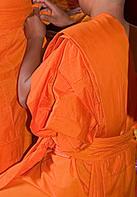July 7, 2009
Western Buddhism stands accused of not being ‘authentic’. But will a search for the genuine article lead us anywhere?
 London, UK — In the days when I was an Indian classical dancer, we were beset by doubts and anxieties about authenticity. How could we possibly practise an ancient art form in the rootless west? Were modifications to the form or the teaching method possible? Or were they anathema? If we learned one form of the dance, was it alright to go to a teacher of another form?
London, UK — In the days when I was an Indian classical dancer, we were beset by doubts and anxieties about authenticity. How could we possibly practise an ancient art form in the rootless west? Were modifications to the form or the teaching method possible? Or were they anathema? If we learned one form of the dance, was it alright to go to a teacher of another form?
I was reminded of those anguished late-night debates at Joseph Goldstein’s session at King’s Place for London Insight Meditation on Sunday. Similar anxieties were raised in the questions from the packed and respectful audience. Broadly, they provided a stream of queries that fell into two camps – firstly how to live the dharma in daily life here – “How do I deal “skilfully” with a neighbour who persistently hems my car in?” – and secondly, how precise about its boundaries should western Buddhism be.
There is hardly a better person than Goldstein to deal with both kinds of question. He encountered the Buddhist dharma when he went to Thailand for Peace Corps work in 1965 and signed up for a class. “In those first five minutes, something amazing happened. I saw I could look into my mind as well as looking out through it.” Since then he has become one of the major figures in establishing vipassana/insight meditation in the west, co-founder of the influential Insight Meditation Society in Massachusetts in 1975 and the author of numerous books.
Sitting in an armchair in the centre of a large bare stage, Goldstein is spectacularly at ease. He might be sitting comfortably on his own porch dispensing dharma. He has an attractive way of pondering questions as he answers them, letting himself stop and reflect. Well, he answers the man with the car, “wrathful compassion” is a good start. Of course that doesn’t always work. There was a monastery in the US, he recounted, that was getting constantly plagued by yobs and vandals. The monks tried talking, explaining, expostulating, directing understanding and loving kindness, but all to no avail. Then the abbot said to his monks, “Let the air out of their tyres.” That did it. But remember that it is attitude, Goldstein warned, not action that is the key.
The question of authenticity is rather more complex, and central to the unfolding path of western Buddhism. But it’s not limited to it, as I indicated at the start. I tangled with the question as a student dancer, and also when I was involved in formulating diversity policy. The past 30 years in which we have come slowly (and painfully) to terms with other cultures have similarities to the issues that are raised over Buddhism’s path. Who do different art forms “belong” to? Clearly the arts must change when they come to the west if they are to express current realities. But it has often been a contentious issue, and not only with native speakers who wish to hang on to heritage. It has also been native Brits who often wanted to corral the arts into ethnic corners and could not see their wider relevance.
Change – vital as it is – of course carries dangers that have been well voiced in this blog: the danger of mash-mash, a pick’n’mix approach resulting in a dilution that ends up being so weak that it is of no use to man or mouse. Goldstein’s approach to questioners is both sensible and profound. A grounding in one tradition is vital, he argued, before opening out and at that stage the challenge of a new tradition can be extraordinarily productive. Goldstein himself had followed the austere Burmese tradition of insight meditation for around 25 years when a friend introduced him to Tibetan Buddhism, the antithesis of his own practice. He was immediately overwhelmed and confounded. How could the two interpretations both be true? After gnawing on this insoluble koan for some time he had finally seen two things: firstly that “all teachings are not ultimate, but a skilful means of liberating the heart from clinging” and secondly – he smiled benignly and opened his arms to shrug – “Who knows?”
This quality of trust and openness has a lot to say to the alarm about authenticity. It offers a healthy gloss on inclusiveness – something that British culture is, despite its fabled tolerance, not too good at. We tend to ethnicise both faiths and culture. We see “multiculturalism” as fragmentation and nothing to do with the continuing story of a mainstream culture. Similarly with religions and faiths, they get nailed down into specific geographical areas that provide their identity and definition. Not surprising then, the popular suspicion that Buddhism is all to do with monks in saffron robes and chanting and vegetarianism – doubtless fine for people “over there”, but somehow not belonging, or “authentic”, over here.
Western Buddhism is trying to find a way through these territorial imperatives and to establish its philosophy as a general good. Universality rather than authenticity is a better aim.
By Naseem Khan
Source : The Guardian




